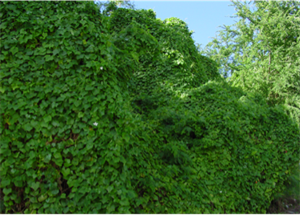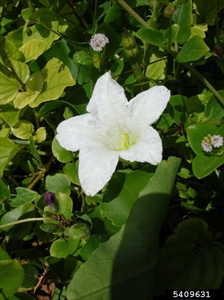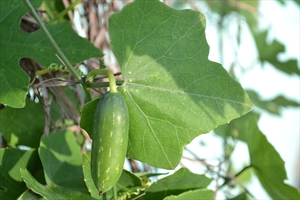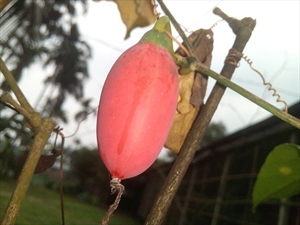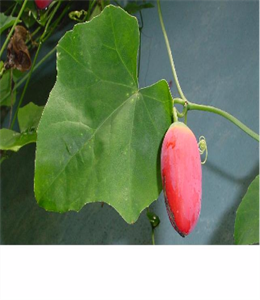- Worldwide distribution. In Australia, Federated States of Micronesia, Fiji, Guam, Marshall Islands, Northern Mariana Islands, Papua New Guinea, Samoa, Solomon Islands, Tonga, Vanuatu.
- Aggressive, fast-growing vine, smothers crops (e.g., sugarcane) and native vegetation, including shrubs, small trees. Common in abandoned gardens, wastelands, roadsides. Environmental weed preventing regeneration of native plants, and impacting diversity. Indirect impacts: host of several important insect pests (cucumber moth, pumpkin beetle, melon fly, aphids, bugs, leafminers, whiteflies).
- Long vines from tuberous roots. Leaves alternate, heart-shaped to 5-lobed, hairy below. Tendrils assist climbing. Separate male and female plants; flowers on stalks up to 5cm, white, five lobes; fruits, smooth, red with brown seeds.
- Spread: tuberous roots and stem pieces; seeds by birds, rodents, possibly pigs. Long distance, medicinal and culinary uses.
- Biosecurity: note, a medicine and a food.
- Biocontrol: stem-boring moth (Melittia oedipus) and leaf-mining beetle (Acythopeus cocciniae) released.
- Cultural control: hand-pulling, removing underground storage roots, collecting and burning stem pieces. Avoid slashing, unless all stem pieces collected.
- Chemical control: in Australia, 2,4-D; 2,4-D + picloram; dicamba; MCPA; triclorpyr; triclorpyr + picloram; triclorpyr + picloram + aminopyralid. Glyphosate, elsewhere.
Pacific Pests, Pathogens and Weeds - Online edition
Pacific Pests, Pathogens, Weeds & Pesticides
Ivy gourd (495)
Ivy gourd. It is also known as the scarlet-fruited gourd, little gourd, scarlet gourd.
Coccinia grandis; previously, it was known as Bryonia grandis, Coccinia cordifolia. It is a member of the Cucurbitaceae.
AUTHOR Grahame Jackson
Information from CABI (2019) Coccinia grandis (scarlet-fruited ivy gourd). Invasive Species Compendium. (https://www.cabi.org/isc/datasheet/14659); and Coccinia grandis (2013) Pacific Island Ecosystems at Risk (PIER). (http://www.hear.org/pier/species/coccinia_grandis.htm); and from Ivy Gourd (Coccinia grandis) (2011) Invasive Species Fact Sheet 05. Pacific Islands Area. USDA NRCS. (https://www.nrcs.usda.gov/Internet/FSE_DOCUMENTS/nrcs142p2_037095.pdf). Photo 1 Mingus 19. (https://commons.wikimedia.org/wiki/File:Invasive_Ivy_Gourd.jpg). Photos 2&5 Forrest & Kim Starr Starr Environmental, Bugwood.org. Photo 4 Jaiprakashsing. Young fruit of Coccinia grandis. (https://commons.wikimedia.org/wiki/File:Young_Coccinia_grandis.jpg). Photo 6 Abdullah AL Shohag. (https://www.flickr.com/photos/189060791@N03/50318670331/in/dateposted/). Photos 3&7) Konrad Englburger, Pohnpei, Federated states of Micronesia.
Produced with support from the Australian Centre for International Agricultural Research under project HORT/2016/185: Responding to emerging pest and disease threats to horticulture in the Pacific islands, implemented by the University of Queensland and the Secretariat of the Pacific Community.


